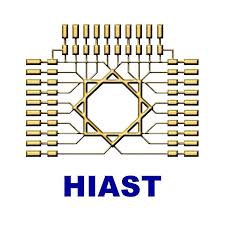The purpose of this report is to document the noise performance of a complex beamforming array antenna system and to characterize the recently developed noise measurement facility called THACO, which was developed at ASTRON. The receiver system inclu
des the array antenna of strongly coupled 144 TSA elements, 144 Low Noise Amplifiers (LNAs) (Tmin =35-40K) and the data recording/storing facilities of the initial test station that allow for off-line digital beamforming. The primary goal of this study is to compare the measured receiver noise temperatures with the simulated values for several practical beamformers, and to predict the associated receiver noise coupling contribution, antenna thermal noise and ground noise pick-up (due to the back radiation).
Aperture arrays have been studied extensively for application in the next generation of large radio telescopes for astronomy, requiring extremely low noise performance. Prototype array systems need to demonstrate the low noise potential of aperture a
rray technology. This paper presents noise measurements for an Aperture Array tile of 144 dual-polarized tapered slot antenna (TSA) elements, originally built and characterized for use as a Phased Array Feed for application in an L-band radio astronomical receiving system. The system noise budget is given and the dependency of the measured noise temperatures on the beam steering is discussed. A comparison is made of the measurement results with simulations of the noise behavior using a system noise model. This model includes the effect of receiver noise coupling, resulting from a changing active reflection coefficient and array noise contribution as a function of beam steering. Measurement results clearly demonstrate the validity of the model and thus the concept of active reflection coefficient for the calculation of effective system noise temperatures. The presented array noise temperatures, with a best measured value of 45 K, are state-of-the-art for room temperature aperture arrays in the 1 GHz range and illustrate their low noise potential.
This paper discusses an outdoor test facility for the noise characterization of active antenna arrays, using measurement results of array noise temperatures in the order of 50 K for a number of small aperture arrays. The measurement results are obtai
ned by a Y-factor method with hot and a cold noise sources, with an absorber at room temperature as the hot load and the cold sky as the cold load. The effect of shielding the arrays by the test facility, with respect to noise and RFI from the environment, will also be discussed.
A concept of an axi-symmetric dish as antenna reflector for the next generation radio telescope - the Square Kilometre Array (SKA) - is presented. The reflector is based on the use of novel thermoplastic composite material (reinforced with carbon fib
re) in the context of the telescope design with wide band single pixel feeds. The baseline of this design represents an array of 100s to 1000s reflector antennas of 15-m diameter and covers frequencies from <1 to 10 GHz. The purpose of our study is the analysis of the production cost of the dish and its performance in combination with a realistic wideband feed (such as the Eleven Antenna feed) over a wide frequency band and a range of elevation angles. The presented initial simulation results inidicate the potential of the proposed dish concept for low-cost and mass production and demonstrate sensitivity comparable to that of the presently considered off-set Gregorian reflector antenna with the same projected aperture area. We expect this observation to be independent of the choice of the feed, as several other single-pixel wideband feeds (that have been reported in the literature) have similar beamwidth and phase center location, both being rather constant with frequency.
The results of four recently introduced beamforming schemes for phased array systems are discussed, each of which is capable to provide high sensitivity and accurate polarimetric performance of array-based radio telescopes. Ideally, a radio polarimet
er should recover the actual polarization state of the celestial source, and thus compensate for unwanted polarization degradation effects which are intrinsic to the instrument. In this paper, we compare the proposed beamforming schemes through an example of a practical phased array system (APERTIF prototype) and demonstrate that the optimal beamformer, the max-SLNR beamformer, the eigenvector beamformer, and the bi-scalar beamformer are sensitivity equivalent but lead to different polarization state solutions, some of which are sub-optimal.


